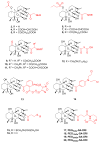Discovery and development of natural product oridonin-inspired anticancer agents
- PMID: 27344488
- PMCID: PMC5003635
- DOI: 10.1016/j.ejmech.2016.06.015
Discovery and development of natural product oridonin-inspired anticancer agents
Abstract
Natural products have historically been, and continue to be, an invaluable source for the discovery of various therapeutic agents. Oridonin, a natural diterpenoid widely applied in traditional Chinese medicines, exhibits a broad range of biological effects including anticancer and anti-inflammatory activities. To further improve its potency, aqueous solubility and bioavailability, the oridonin template serves as an exciting platform for drug discovery to yield better candidates with unique targets and enhanced drug properties. A number of oridonin derivatives (e.g. HAO472) have been designed and synthesized, and have contributed to substantial progress in the identification of new agents and relevant molecular mechanistic studies toward the treatment of human cancers and other diseases. This review summarizes the recent advances in medicinal chemistry on the explorations of novel oridonin analogues as potential anticancer therapeutics, and provides a detailed discussion of future directions for the development and progression of this class of molecules into the clinic.
Keywords: Anticancer agents; Chemical biology; Diterpenoids; Drug discovery; Natural product; Oridonin.
Copyright © 2016 Elsevier Masson SAS. All rights reserved.
Conflict of interest statement
The authors confirm that this article content has no conflicts of interest.
Figures












Similar articles
-
The conversion of oridonin to spirolactone-type or enmein-type diterpenoid: synthesis and biological evaluation of ent-6,7-seco-oridonin derivatives as novel potential anticancer agents.Eur J Med Chem. 2012 Jun;52:242-50. doi: 10.1016/j.ejmech.2012.03.024. Epub 2012 Mar 23. Eur J Med Chem. 2012. PMID: 22483090
-
Recent Development of Oridonin Derivatives with Diverse Pharmacological Activities.Mini Rev Med Chem. 2019;19(2):114-124. doi: 10.2174/1389557517666170417170609. Mini Rev Med Chem. 2019. PMID: 28425866 Review.
-
Synthesis of Oridonin Derivatives via Mizoroki-Heck Reaction and Click Chemistry for Cytotoxic Activity.Anticancer Agents Med Chem. 2019;19(7):935-947. doi: 10.2174/1871520619666190118121439. Anticancer Agents Med Chem. 2019. PMID: 30657049
-
Chemical proteomics reveals HSP70 1A as a target for the anticancer diterpene oridonin in Jurkat cells.J Proteomics. 2013 Apr 26;82:14-26. doi: 10.1016/j.jprot.2013.01.030. Epub 2013 Feb 15. J Proteomics. 2013. PMID: 23416714
-
Therapeutic Potential of Oridonin and Its Analogs: From Anticancer and Antiinflammation to Neuroprotection.Molecules. 2018 Feb 22;23(2):474. doi: 10.3390/molecules23020474. Molecules. 2018. PMID: 29470395 Free PMC article. Review.
Cited by
-
Biophysical and biochemical properties of PHGDH revealed by studies on PHGDH inhibitors.Cell Mol Life Sci. 2021 Dec 31;79(1):27. doi: 10.1007/s00018-021-04022-2. Cell Mol Life Sci. 2021. PMID: 34971423 Free PMC article.
-
Induction of the mitochondria-mediated apoptosis in human esophageal cancer cells by DS2, a newly synthetic diterpenoid analog, is regulated by Bax and caused by generation of reactive oxygen species.Oncotarget. 2016 Dec 27;7(52):86211-86224. doi: 10.18632/oncotarget.13367. Oncotarget. 2016. PMID: 27863415 Free PMC article.
-
Enhancing cancer therapy: advanced nanovehicle delivery systems for oridonin.Front Pharmacol. 2024 Dec 3;15:1476739. doi: 10.3389/fphar.2024.1476739. eCollection 2024. Front Pharmacol. 2024. PMID: 39691396 Free PMC article. Review.
-
Diterpenoids from the aerial parts of Isodon serra and their anti-hepatocarcinoma potential.RSC Adv. 2025 Jun 23;15(25):20134-20142. doi: 10.1039/d5ra02720a. eCollection 2025 Jun 10. RSC Adv. 2025. PMID: 40551991 Free PMC article.
-
Oridonin, a Promising ent-Kaurane Diterpenoid Lead Compound.Int J Mol Sci. 2016 Aug 24;17(9):1395. doi: 10.3390/ijms17091395. Int J Mol Sci. 2016. PMID: 27563888 Free PMC article. Review.
References
Publication types
MeSH terms
Substances
Grants and funding
LinkOut - more resources
Full Text Sources
Other Literature Sources

